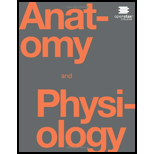
Concept explainers
Watch this video (http://openstaxcollege.org/l/micromacro) to learn more about macro- and microstructures of skeletal muscles. (a) What are the names of the “junction points” between sarcomeres? (b) What are the names of the “subunits” within the myofibrils that run the length of skeletal muscle fibers? (c) What is the “double strand of pearlsâ€� described in the video? (d) What gives a skeletal muscle fiber its striated appearance?
(a) To write:
The names of junction points between sarcomeres.
Introduction:
Sarcomeres are the units of the skeletal muscle which are formed of muscle fibers. Many sarcomeres together form myofibrils.
Explanation of Solution
Sarcomeres are the units of muscles and junction points between sarcomeres is Z line. In between two Z lines, two sarcomere units are present. At Z line, actin filaments or the ends of sarcomere are present.
Junction points between sarcomeres is known as Z line.
(b) To write:
The name of subunits of myofibrils.
Introduction:
Myofibrils are elongated thread like structures in the skeletal muscles. Many myofibrils together form skeletal muscles.
Explanation of Solution
The subunit of myofibrils are sarcomeres. Sarcomeres are the basic units of a skeletal muscle which together form myofibrils. These myofibrils together form a skeletal muscle.
Subunits of myofibrils are sarcomeres.
(c) To write:
To determine what double strands of pearl means in the video.
Introduction:
In the given video double strands of pearl shows the arrangement of actin and myosin filament.
Explanation of Solution
In the given video, arrangement of actin filaments of skeletal muscle is shown. Actin filament is a thin filament which is formed by a double chain of many subunits. Both the chains are twisted and this resembles the structure of double strands of pearl.
Double strands of pearl resemble twisted double chain of actin filaments formed of many subunits.
(d) To write:
To determine the reason of striated appearance of skeletal muscle.
Introduction:
Skeletal muscles have striated appearance due to presence of alternating dark and light bands in them.
Explanation of Solution
Due to arrangement of myosin and actin filaments, light and dark bands are formed. This gives striated appearance to the skeletal muscle. The A bands forms the dark bands as they have both actin and myosin filaments in them giving a dark appearance. The I bands forms light bands as they have only thin actin filaments in them. This results in striated appearance of a skeletal muscle.
Striated appearance of skeletal muscle is formed by dark A bands and light I bands formed by arrangement of actin and myosin filaments of the muscle.
Want to see more full solutions like this?
Chapter 10 Solutions
Anatomy & Physiology
Additional Science Textbook Solutions
Human Anatomy & Physiology (2nd Edition)
Concepts of Genetics (12th Edition)
Biological Science (6th Edition)
Campbell Biology in Focus (2nd Edition)
Campbell Biology: Concepts & Connections (9th Edition)
Genetic Analysis: An Integrated Approach (3rd Edition)
- Which of the following is not a DNA binding protein? 1. the lac repressor protein 2. the catabolite activated protein 3. the trp repressor protein 4. the flowering locus C protein 5. the flowering locus D protein 6. GAL4 7. all of the above are DNA binding proteinsarrow_forwardWhat symbolic and cultural behaviors are evident in the archaeological record and associated with Neandertals and anatomically modern humans in Europe beginning around 35,000 yBP (during the Upper Paleolithic)?arrow_forwardDescribe three cranial and postcranial features of Neanderthals skeletons that are likely adaptation to the cold climates of Upper Pleistocene Europe and explain how they are adaptations to a cold climate.arrow_forward
- Biology Questionarrow_forward✓ Details Draw a protein that is embedded in a membrane (a transmembrane protein), label the lipid bilayer and the protein. Identify the areas of the lipid bilayer that are hydrophobic and hydrophilic. Draw a membrane with two transporters: a proton pump transporter that uses ATP to generate a proton gradient, and a second transporter that moves glucose by secondary active transport (cartoon-like is ok). It will be important to show protons moving in the correct direction, and that the transporter that is powered by secondary active transport is logically related to the proton pump.arrow_forwarddrawing chemical structure of ATP. please draw in and label whats asked. Thank you.arrow_forward
- Outline the negative feedback loop that allows us to maintain a healthy water concentration in our blood. You may use diagram if you wisharrow_forwardGive examples of fat soluble and non-fat soluble hormonesarrow_forwardJust click view full document and register so you can see the whole document. how do i access this. following from the previous question; https://www.bartleby.com/questions-and-answers/hi-hi-with-this-unit-assessment-psy4406-tp4-report-assessment-material-case-stydu-ms-alecia-moore.-o/5e09906a-5101-4297-a8f7-49449b0bb5a7. on Google this image comes up and i have signed/ payed for the service and unable to access the full document. are you able to copy and past to this response. please see the screenshot from google page. unfortunality its not allowing me attch the image can you please show me the mathmetic calculation/ workout for the reult sectionarrow_forward
 Human Physiology: From Cells to Systems (MindTap ...BiologyISBN:9781285866932Author:Lauralee SherwoodPublisher:Cengage Learning
Human Physiology: From Cells to Systems (MindTap ...BiologyISBN:9781285866932Author:Lauralee SherwoodPublisher:Cengage Learning Human Biology (MindTap Course List)BiologyISBN:9781305112100Author:Cecie Starr, Beverly McMillanPublisher:Cengage Learning
Human Biology (MindTap Course List)BiologyISBN:9781305112100Author:Cecie Starr, Beverly McMillanPublisher:Cengage Learning Anatomy & PhysiologyBiologyISBN:9781938168130Author:Kelly A. Young, James A. Wise, Peter DeSaix, Dean H. Kruse, Brandon Poe, Eddie Johnson, Jody E. Johnson, Oksana Korol, J. Gordon Betts, Mark WomblePublisher:OpenStax College
Anatomy & PhysiologyBiologyISBN:9781938168130Author:Kelly A. Young, James A. Wise, Peter DeSaix, Dean H. Kruse, Brandon Poe, Eddie Johnson, Jody E. Johnson, Oksana Korol, J. Gordon Betts, Mark WomblePublisher:OpenStax College Biology 2eBiologyISBN:9781947172517Author:Matthew Douglas, Jung Choi, Mary Ann ClarkPublisher:OpenStax
Biology 2eBiologyISBN:9781947172517Author:Matthew Douglas, Jung Choi, Mary Ann ClarkPublisher:OpenStax





